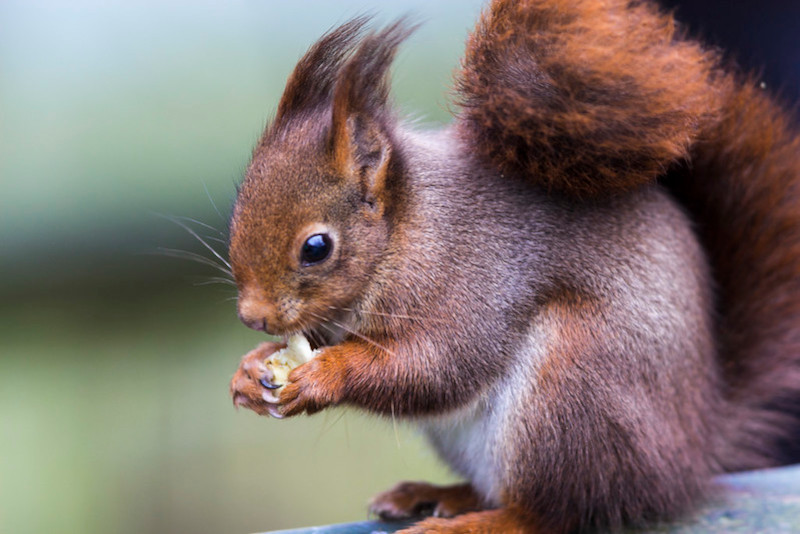
Eurasian Red Squirrel Facts
- This gorgeous creation of Nature and evolution most frequently goes by the descriptive and informative common name of Eurasian Red Squirrel. Yet, in many parts of the animal’s territory, it’s also sometimes simply called the Red Squirrel.
- Inside of many scientific circles, however, it’s perhaps better known by its technical title. Thankfully, that’s a comparatively easy term for the average layperson to pronounce. That’s because the animal holds the official moniker of the Sciurus vulgaris.
- The beautiful creature received that appellation due to the efforts of Carl Linnnaeus. The eminent Swedish zoologist accomplished the first recognition of it as a separate and distinct species. He manged that scientifically noteworthy deed in 1758.
- Research indicates that the numbers of this marvel of Nature recently declined dramatically. Many experts attribute that to the introduction of a related species from another part of the world into its range. Its numbers do seem to be stabilizing, though.
- Fortunately, despite this situation, its overall population appears to still be sufficient. Even with the recent developments, that condition also seems to hold true in most sections of its range. The IUCN thus still lists the natural wonder as Least Concern.
- The small rodent nevertheless continues to face multiple, ever-increasing threats to its continued existence as a species. Most of these dangers stem from the actions of man. These perils include the related threats of habitat loss and ongoing climate change.
Related Articles
Eurasian Red Squirrel Physical Description
This breathtaking small mammal almost instantly captures the attention and interest of those fortunate enough to encounter it. Like its many relatives around the world, though, it typically does so more for its appearance, than because of any impressive measurements.
In terms of dimensions and outward form, it follows a pattern shared by those related species. That’s in the fact that, unlike many species, it displays no noticeable degree of the physiological characteristic of sexual dimorphism. Telling the sexes apart can be difficult.
Overall, individuals of both genders attain average head-and-body lengths of approximately 7.5 – 9 in (19 – 23 cm). The tail also adds an extra mean length of 6 – 8 in (15 – 20 cm). It’s therefore slightly smaller than the Eastern Gray Squirrel in the United States.
Weights for both sexes also remains roughly equal, at least as a general principle. During pregnancy, however, females understandably exceed that temporarily. Otherwise, an average mass for fully mature adults measures around 0.56 – 0.75 lb (0.25 – 0.34 kg).
It’s the color of the aptly-named Eurasian Red Squirrel that usually garners the most interest, though. Yet, despite the implications of the name, the animal isn’t always red in color. This aspect varies in color due to both season of the year and geographical location.
Between these different factors, however, a range remains prevalent. The shades it manifests on the back, sides, and head run from the namesake red, the most common, to as dark as black! Regardless of which of these appear, though, the stomach always shows an of-white.
- Kingdom: Animalia
- Phylum: Chordata
- Class: Mammalia
- Order: Rodentia
- Family: Sciuridae
- Genus: Sciurus
- Species: S. vulgaris
Eurasian Red Squirrel Distribution, Habitat, and Ecology
The beautiful Eurasian Red Squirrel evolved as native to a moderately large expanse of the earth’s surface. That general zone of habitation isn’t surprising to many people, though. After all, the very name of this biological masterpiece indicates where that territory lies.
As implied, the creature developed as endemic to a portion of both Europe and Asia. On the continent of Europe, the eye-catching rodent lives across most of its expanse. In Asia, though, it primarily appears in the more northerly parts of that part of its native range.
The remarkable fauna displays a decidedly strong degree of flexibility regarding its choice of habitat type. That’s true since it inhabits different ecosystems in various parts of the overall range. This high level of adaptability represents a powerful evolutionary advantage.
In southern and western Europe, it mainly lives in coniferous forests. These allow for a good mix of shrubs and trees. In northern Europe and parts of Asia, however, the rodent often lives in coniferous forests. Here, it shows a preference for several types of pines.
The amazing Eurasian Red Squirrel developed as principally solitary in nature. The exceptions to this mostly consist of breeding season and sharing a nest for warmth in winter. These small, dome-shaped nests the animal generally constructs in the forks of trees.
The lovely mammal also amost entirely herbivorous in its dietary preferences. It mostly consumes various seeds, nuts, berries, flowers, shoots, and even tree sap. Yet, on rare occasions, it’s even known to feed on the eggs of birds, or even on the young hatchlings.
Species Sharing Its Range
Check out our other articles on 4 Gorgeous European Gorges, Eurasian Brown Bear, Uluru, Axolotl, Red Maple, Wolf Eel, East African Lowland Honey Bee, California red-sided garter snake
